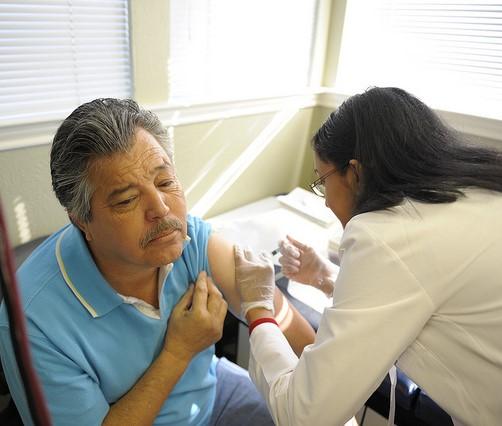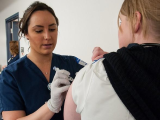A study of Medicare beneficiaries vaccinated against the flu last season—a severe one dominated by the H3N2 strain that hit seniors especially hard—found that the cell-based vaccine performed better than egg-based vaccines, but the difference wasn't enough to completely pin the low overall efficacy last season on egg adaptations in the vaccine strain.
The findings are helpful for policymakers but leave scientists with the ongoing complex task of unraveling all the factors that explain gaps in protection for flu vaccines, especially against the H3N2 strain. A team led by researchers from the US Food and Drug Administration and the Centers for Medicare and Medicaid Services reported its findings today in the Journal of Infectious Diseases.
Comparing 5 vaccine formulations
The retrospective cohort study included more than 13 million seniors ages 65 and older who received one of five flu vaccine formulations last season: Flucelvax (made by Seqirus), egg-based quadrivalent (four-strain), egg-based high-dose, adjuvanted, and standard-dose vaccines. The last three versions are all trivalent (three-strain).
Though an earlier study suggested that the cell-based recombinant vaccine (Flublok, made by Protein Sciences) produced in insect cells was more effective than standard egg-based vaccines, it wasn't evaluated in the study, because it wasn't used in enough Medicare recipients to allow analysis. The cell-based vaccine the researchers did analyze contained a cell-cultured H3N2 vaccine strain component for the first time last season, though the 2009 H1N1 and influenza B vaccine viruses were produced from egg-adapted viruses.
Of the seniors who were vaccinated through the end of January, 5% got cell-cultured quadrivalent, 14% egg-based quadrivalent, and 63%, 11%, and 7% received the high-dose, adjuvanted, and standard-dose trivalent, respectively.
To gauge differences in how well all versions performed against each other, the main factor the researchers looked at was their impact against flu-related hospitalizations and emergency room visits.
Cell-culture, high-dose vaccines protected best
The group's analysis revealed that the effectiveness of the cell-cultured vaccine was about 10% to 11% higher than standard-dose egg-based quadrivalent vaccines in preventing flu hospital encounters, inpatient stays, and clinic visits. Of all five vaccines measured, relative vaccine effectiveness against hospitalizations and emergency visits was highest for cell-based (11%) and high-dose (9%) vaccines.
Though virologic evidence supports higher relative efficacy for cell-cultured vaccines, which could be because of adaptations during preparing and growing H3N2 vaccine viruses, the researchers said their study doesn't rule out a role for other factors in explaining the differences they found.
Unlike previous years, lab studies last season did not find that antigenic drift in the circulating H3N2 strain was associated with reduced vaccine efficacy. "Other possibilities, including a neuraminidase drift, should be explored to help explain the low [vaccine effectiveness] reported among persons ages ≥65 years," they wrote.
An interim relative vaccine efficacy estimate in the middle of January based on Medicare data comparing cell-cultured and comparable egg-based vaccines was somewhat higher than end-of-the-year findings reported in today's study, which they said could reflect an increase in the proportion of influenza B viruses later in the season or waning protection.
However, they said the early-season relative vaccine efficacy estimate may be useful for selecting seasonal flu vaccine strains for the following season. The team also wrote that the methods they developed for using real-world data to estimate the relative effectiveness of vaccine used by Medicare participants could help fine-tune vaccination strategies for this vulnerable age-group during epidemics and pandemics.
Findings raise new possibilities
In an accompanying editorial, two epidemiologists from the Centers for Disease Control and Prevention's (CDC's) Influenza Division wrote that understanding why seasonal flu vaccines are less effective against H3N2 and findings new ways to improve protection are critical, especially in H3N2-dominant seasons such as 2017-18. The authors are Brendan Flannery, PhD, MPH, and Alicia Fry, MD.
They said the relative effectiveness difference between the cell-culture and high-dose vaccine wasn't statistically significant and that better effectiveness of the cell-culture vaccine was likely due to the H3N2 cell-derived component. The small relative increase suggests that egg-adaptation changes don't entirely explain the lower vaccine effectiveness for H3N2 viruses, they add.
"One wonders how a vaccine with higher dose and absence of egg-adaptation changes would have compared in this study," Flannery and Fry wrote
They also noted that the cell-culture and high-dose vaccines had 5% to 7% higher relative effectiveness than the adjuvanted egg-based vaccine, which was 4% more effective than standard egg-based vaccines.
"This suggests that adjuvant worked less well than increased antigen dose at improving effectiveness against A(H3N2) viruses," they wrote, adding that it would be useful to know if adjuvanted vaccines offer benefits against antigenically drifted viruses, plus 2009 H1N1 and B viruses, as well as what role an adjuvanted cell-culture vaccine might play.
Regarding the method the study group used to evaluate the vaccines, Flannery and Fry wrote that one benefit, for example, is that the approach doesn't require an unvaccinated cohort. They added, however, that the approach doesn't allow determination of absolute vaccine effectiveness for any vaccine, though they note that the researchers were able to make estimates for each vaccine type.
Factoring in changes in the use of different vaccines over time will be helpful, they wrote, and studies using lab-confirmed flu outcomes are needed to determine effectiveness of different vaccines by virus types and subtypes—setting the scene for multiple complementary studies that can show results over several seasons.
"The lessons we learn from these studies will help improve influenza vaccines and vaccine strategies so that we optimize the protection provided by seasonal influenza vaccines," they wrote.
See also:
Dec 18 J Infect Dis abstract
Dec 18 J Infect Dis editorial




















